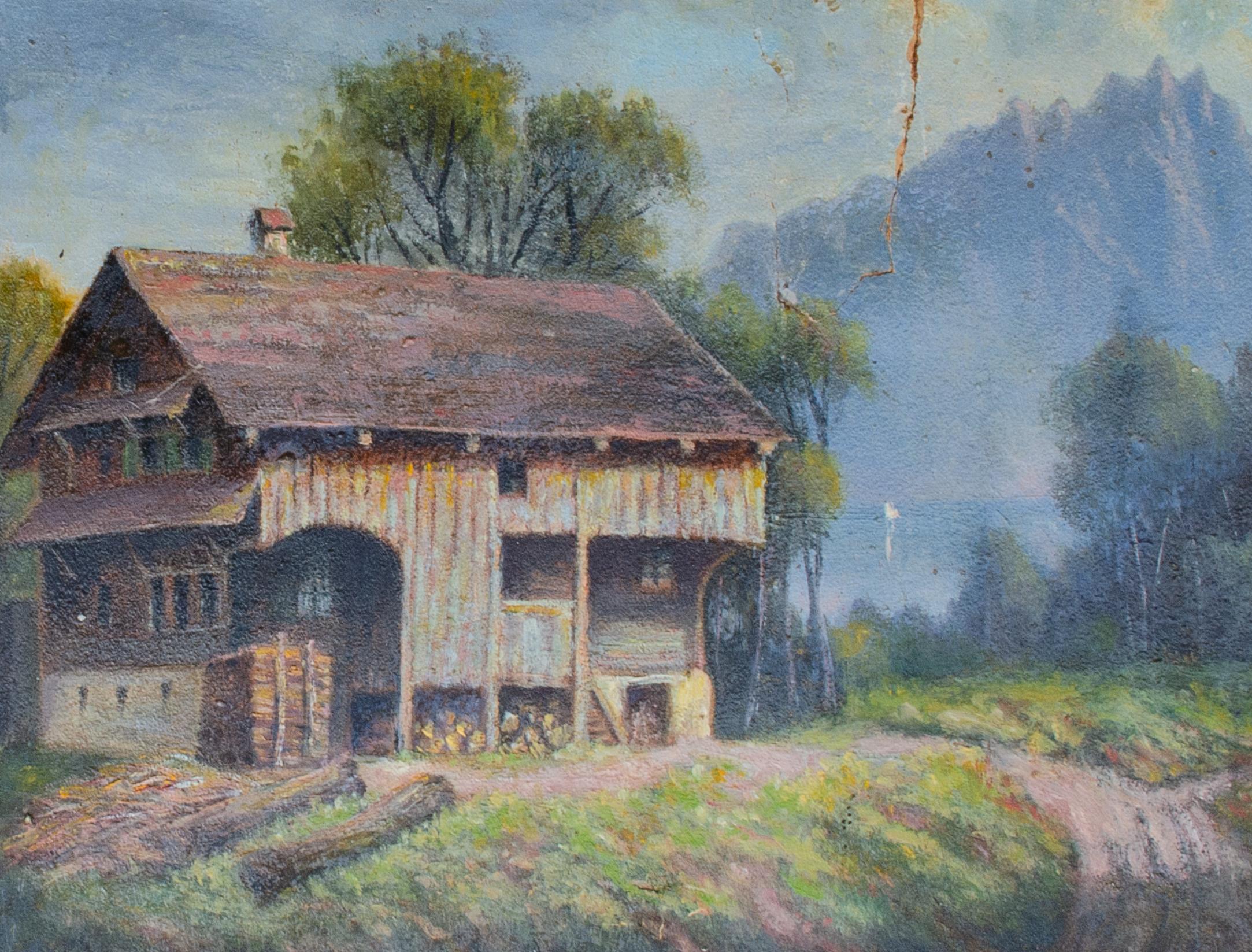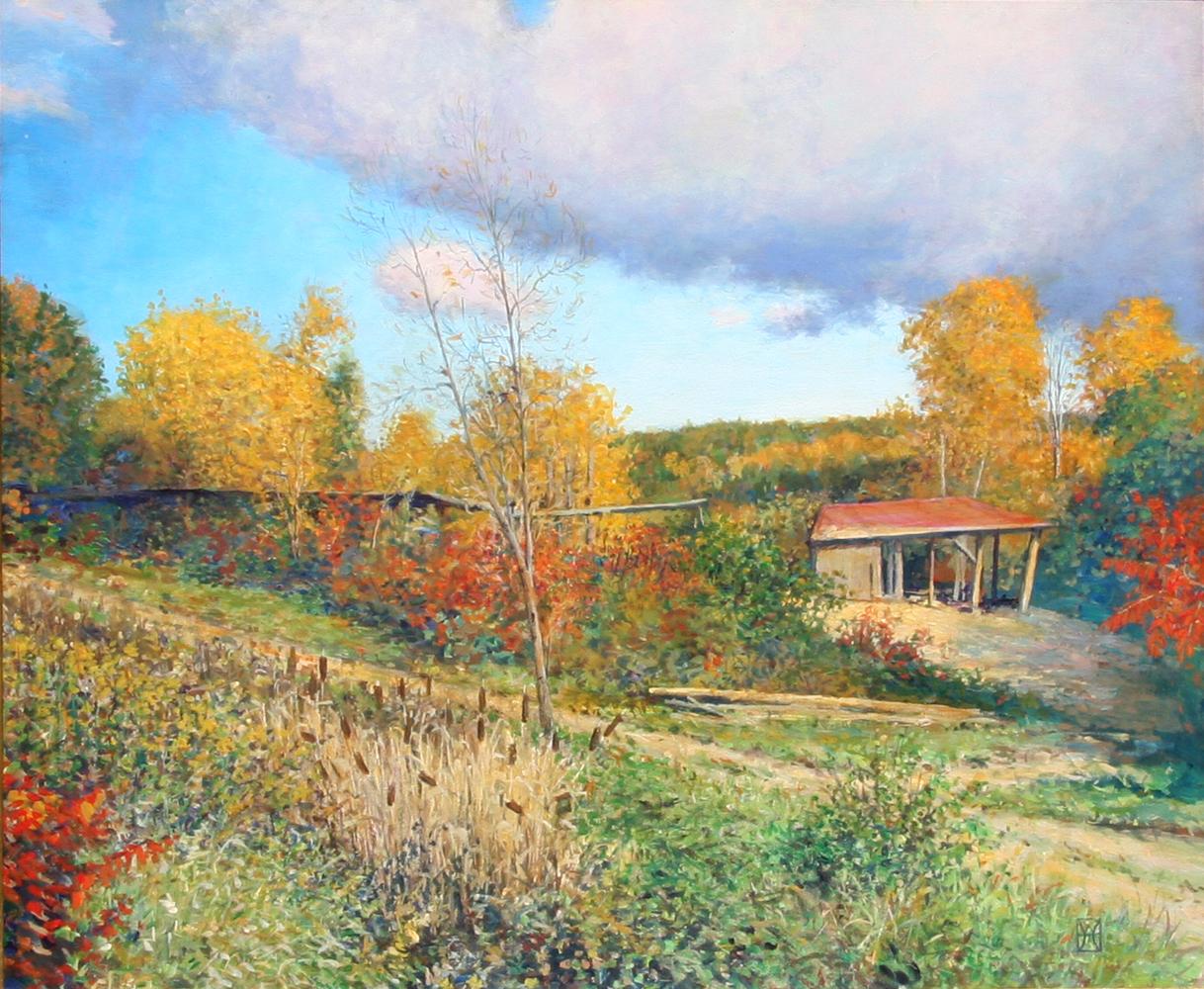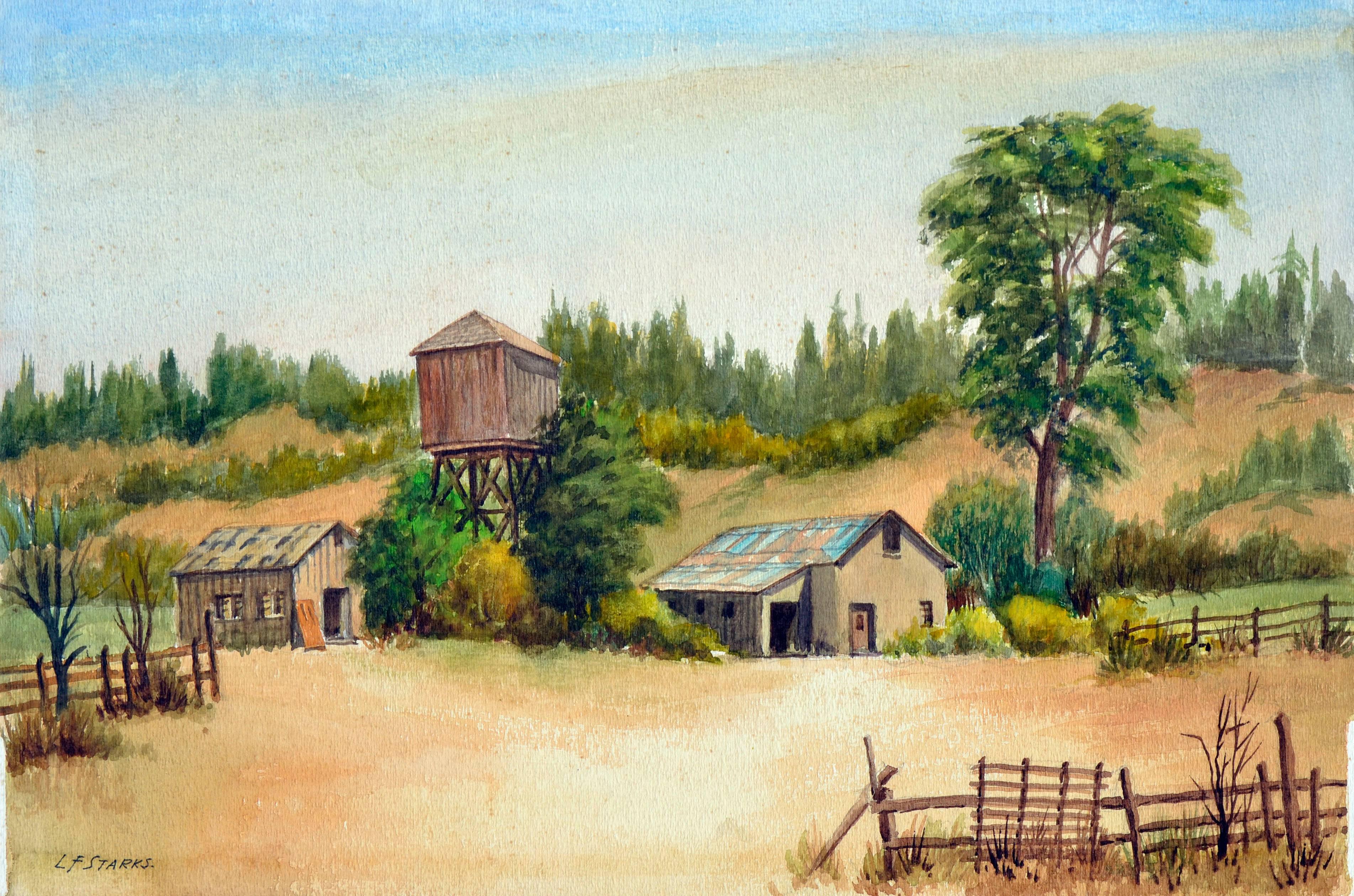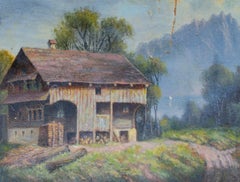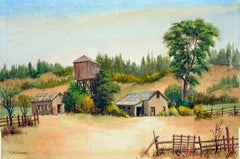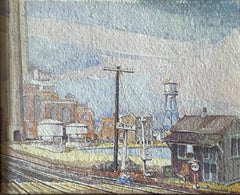Items Similar to The Old Factory
Want more images or videos?
Request additional images or videos from the seller
1 of 8
Arnold A. GrossmanThe Old Factoryc.1980
c.1980
$400
£300.96
€347.62
CA$565.30
A$613.44
CHF 325.07
MX$7,523.56
NOK 4,022.72
SEK 3,801.25
DKK 2,595.15
About the Item
Artist: Arnold Grossman (American, 1923-2016)
Title: The Old Factory
Year: c.1980
Medium: Watercolor
Paper: Watercolor paper
Size image: 16 x 21 inches
paper: 16 x 21 inches
Signature: Signed lower lower right by the artist
Condition: excellent
About the artist.
Arnold A. Grossman, born March 23, 1923, in Oakland, California, died July 29, 2016, in San Francisco. Arnold was was raised, in Napa, California. He graduated from the San Rafael Military Academy in 1941. He then attended Pomona College, but his studies were halted due to the war. He served in the United States Army during World War II and was seriously wounded in battle in the European field. He faced an arduous recovery when he returned home. He eventually made his home in San Francisco. Arnold was taking advantage of all of the culture that San Francisco has to offer to influence his work. He was especially known for his colorful watercolor depicting San Francisco Bay Area scenes, he also randomly created semi abstract paintings and watercolors. Arnold was a supporter of many cultural and Jewish institutions in San Francisco. He also enjoyed traveling and many of his painting are depicting Latin American scenes. He was a gifted artist and showed his work in numerous exhibits throughout the Bay Area, including the Coastal Arts League in Half Moon Bay. Even as he was suffering from his health in older age, Arnold continued painting. The Rhoda Goldman Plaza in San Francisco, has featured his work. The Work of This noted California artist is held in many private collections in the San Francisco Bay Area and California.
- Creator:Arnold A. Grossman (1923 - 2016)
- Creation Year:c.1980
- Dimensions:Height: 16 in (40.64 cm)Width: 21 in (53.34 cm)Depth: 0.01 in (0.26 mm)
- Medium:
- Movement & Style:
- Period:
- Condition:
- Gallery Location:San Francisco, CA
- Reference Number:Seller: gro/old/fac/011stDibs: LU66635921622
About the Seller
5.0
Platinum Seller
Premium sellers with a 4.7+ rating and 24-hour response times
Established in 1999
1stDibs seller since 2017
832 sales on 1stDibs
Typical response time: 1 hour
- ShippingRetrieving quote...Shipping from: San Francisco, CA
- Return Policy
Authenticity Guarantee
In the unlikely event there’s an issue with an item’s authenticity, contact us within 1 year for a full refund. DetailsMoney-Back Guarantee
If your item is not as described, is damaged in transit, or does not arrive, contact us within 7 days for a full refund. Details24-Hour Cancellation
You have a 24-hour grace period in which to reconsider your purchase, with no questions asked.Vetted Professional Sellers
Our world-class sellers must adhere to strict standards for service and quality, maintaining the integrity of our listings.Price-Match Guarantee
If you find that a seller listed the same item for a lower price elsewhere, we’ll match it.Trusted Global Delivery
Our best-in-class carrier network provides specialized shipping options worldwide, including custom delivery.More From This Seller
View AllEarl Scwaiger's Barn
Located in San Francisco, CA
This artwork titled "Earl Scwaiger's Barn" c.1980 is a watercolor on paper by American artist W. Ralph Murray, 1932-2009. It is signed at the lower righ...
Category
Late 20th Century American Impressionist Landscape Drawings and Watercolors
Materials
Watercolor
The Concrete Plant
By Arnold A. Grossman
Located in San Francisco, CA
Artist: Arnold Grossman (American, 1923-2016)
Title: The concrete Plant
Year: c.1970
Medium: Watercolor
Paper: Watercolor paper
Image size: 11.25 x...
Category
Late 20th Century American Impressionist Landscape Drawings and Watercolors
Materials
Watercolor
The Abandoned Factory
By William Frates
Located in San Francisco, CA
This artwork titled "The Abandoned Factory" c.1945 is an oil painting on canvas by noted California artist William E. Frates, 1891-969 It is signed at the lower right corner by the artist. The canvas size is 24 x 30 inches, framed is 40.75 x 34.5 inches. Custom framed in a wooden gold brownish frame, with fabric liner. This particular artwork has been exhibited at the California Palace of the Legion of Honor Museum in San Francisco, August to April 1946.
About the artist:
Painter, etcher. Born in Hayward, CA in 1896. Frates first studied art in San Francisco with Wm Otto...
Category
Mid-20th Century American Impressionist Landscape Paintings
Materials
Oil
Old Barn, Near Auburn
By Clifford Holmes
Located in San Francisco, CA
This artwork titled "Old Barn Near Auburn" c.1950 is an oil painting on canvas by noted California artist Clifford Holmes 1876-1963. It is signed at the lower...
Category
Mid-20th Century American Impressionist Figurative Paintings
Materials
Oil
Landscape with House
Located in San Francisco, CA
This artwork "Landscape with House" is a watercolor by noted California artist Earl Thollander, 1923-2001. It is signed at the lower right corner by th...
Category
Late 20th Century American Impressionist Landscape Drawings and Watercolors
Materials
Watercolor
Landscape with House, California
By Ralph Ledesma
Located in San Francisco, CA
This artwork titled "Landscape with House, California" is a watercolor on paper by California artist Ralph Ledesma, 1910-1993. It is signed at the lower right corner by the artist. T...
Category
Mid-20th Century American Impressionist Landscape Drawings and Watercolors
Materials
Watercolor
You May Also Like
Vibrant German Watercolor of a Mill, 19th Century
Located in New York, NY
Untitled (Mill), 19th Century
Watercolor on paper
5 x 7 in.
Mat: 8 x 10 in.
Partial inscription verso
Category
19th Century Impressionist Landscape Drawings and Watercolors
Materials
Paper, Watercolor
The Old Sawmill at Westminster, Impressionist Oil Painting by Wally Ames
By Wally Ames
Located in Long Island City, NY
Artist: Wally Ames, American (1942 - )
Title: The Old Sawmill at Westminster, Vermont
Medium: Oil on Masonite, signed l.r. and verso
Size: 20 x 24 inches
Category
1980s Post-Impressionist Landscape Paintings
Materials
Masonite, Oil
Ward Ranch Landscape
By Leonard Frank Starks
Located in Soquel, CA
"Ward Ranch", a detailed watercolor landscape by Leonard Frank Starks (American, 1891-1986). Unframed. Signed "L F Starks" lower left. Titled "Ward Ranch-Carlotta" and dated "9-69" o...
Category
1960s American Impressionist Landscape Drawings and Watercolors
Materials
Watercolor, Rag Paper
$636 Sale Price
20% Off
"Train Station, " Max Kuehne, Industrial City Scene, American Impressionism
By Max Kuehne
Located in New York, NY
Max Kuehne (1880 - 1968)
Train Station, circa 1910
Watercolor on paper
8 1/4 x 10 1/4 inches
Signed lower right
Provenance:
Private Collection, Illinois
Max Kuehne was born in Halle, Germany on November 7, 1880. During his adolescence the family immigrated to America and settled in Flushing, New York. As a young man, Max was active in rowing events, bicycle racing, swimming and sailing. After experimenting with various occupations, Kuehne decided to study art, which led him to William Merritt Chase's famous school in New York; he was trained by Chase himself, then by Kenneth Hayes Miller. Chase was at the peak of his career, and his portraits were especially in demand. Kuehne would have profited from Chase's invaluable lessons in technique, as well as his inspirational personality. Miller, only four years older than Kuehne, was another of the many artists to benefit from Chase's teachings. Even though Miller still would have been under the spell of Chase upon Kuehne's arrival, he was already experimenting with an aestheticism that went beyond Chase's realism and virtuosity of the brush. Later Miller developed a style dependent upon volumetric figures that recall Italian Renaissance prototypes.
Kuehne moved from Miller to Robert Henri in 1909. Rockwell Kent, who also studied under Chase, Miller, and Henri, expressed what he felt were their respective contributions: "As Chase had taught us to use our eyes, and Henri to enlist our hearts, Miller called on us to use our heads." (Rockwell Kent, It's Me O Lord: The Autobiography of Rockwell Kent. New York: Dodd, Mead and Co., 1955, p. 83). Henri prompted Kuehne to search out the unvarnished realities of urban living; a notable portion of Henri's stylistic formula was incorporated into his work.
Having received such a thorough foundation in art, Kuehne spent a year in Europe's major art museums to study techniques of the old masters. His son Richard named Ernest Lawson as one of Max Kuehne's European traveling companions. In 1911 Kuehne moved to New York where he maintained a studio and painted everyday scenes around him, using the rather Manet-like, dark palette of Henri.
A trip to Gloucester during the following summer engendered a brighter palette. In the words of Gallatin (1924, p. 60), during that summer Kuehne "executed some of his most successful pictures, paintings full of sunlight . . . revealing the fact that he was becoming a colorist of considerable distinction." Kuehne was away in England the year of the Armory Show (1913), where he worked on powerful, painterly seascapes on the rocky shores of Cornwall. Possibly inspired by Henri - who had discovered Madrid in 1900 then took classes there in 1906, 1908 and 1912 - Kuehne visited Spain in 1914; in all, he would spend three years there, maintaining a studio in Granada. He developed his own impressionism and a greater simplicity while in Spain, under the influence of the brilliant Mediterranean light. George Bellows convinced Kuehne to spend the summer of 1919 in Rockport, Maine (near Camden). The influence of Bellows was more than casual; he would have intensified Kuehne's commitment to paint life "in the raw" around him.
After another brief trip to Spain in 1920, Kuehne went to the other Rockport (Cape Ann, Massachusetts) where he was accepted as a member of the vigorous art colony, spearheaded by Aldro T. Hibbard. Rockport's picturesque ambiance fulfilled the needs of an artist-sailor: as a writer in the Gloucester Daily Times explained, "Max Kuehne came to Rockport to paint, but he stayed to sail." The 1920s was a boom decade for Cape Ann, as it was for the rest of the nation. Kuehne's studio in Rockport was formerly occupied by Jonas Lie.
Kuehne spent the summer of 1923 in Paris, where in July, André Breton started a brawl as the curtain went up on a play by his rival Tristan Tzara; the event signified the demise of the Dada movement. Kuehne could not relate to this avant-garde art but was apparently influenced by more traditional painters — the Fauves, Nabis, and painters such as Bonnard. Gallatin perceived a looser handling and more brilliant color in the pictures Kuehne brought back to the States in the fall. In 1926, Kuehne won the First Honorable Mention at the Carnegie Institute, and he re-exhibited there, for example, in 1937 (Before the Wind). Besides painting, Kuehne did sculpture, decorative screens, and furniture work with carved and gilded molding. In addition, he designed and carved his own frames, and John Taylor Adams encouraged Kuehne to execute etchings. Through his talents in all these media he was able to survive the Depression, and during the 1940s and 1950s these activities almost eclipsed his easel painting. In later years, Kuehne's landscapes and still-lifes show the influence of Cézanne and Bonnard, and his style changed radically.
Max Kuehne died in 1968. He exhibited his work at the National Academy of Design, the Art Institute of Chicago, the Carnegie Institute in Pittsburgh, the Memorial Art Gallery of the University of Rochester, and in various New York City galleries. Kuehne's works are in the following public collections: the Detroit Institute of Arts (Marine Headland), the Whitney Museum (Diamond Hill...
Category
1910s American Impressionist Landscape Drawings and Watercolors
Materials
Paper, Watercolor
Industrial Landscape Contemporary American Watercolor Magic Realism 20th Century
By Henry Koerner
Located in New York, NY
Industrial Landscape Contemporary American Watercolor Magic Realism 20th Century
Henry Koerner (1915-1991)
J&L Oxygen Plant
18 x 24 1/2 inches
Watercolo...
Category
1980s American Realist Landscape Drawings and Watercolors
Materials
Paper, Watercolor
Oil Refinery, Impressionist Watercolor by Eve Nethercott
By Eve Nethercott
Located in Long Island City, NY
Eve Nethercott, American (1925 - 2015) - Oil Refinery (P1.12), Year: 1959, Medium: Watercolor on Paper, Size: 15 x 22 in. (38.1 x 55.88 cm), Description: Eve Nethercott's abi...
Category
1950s Impressionist Landscape Drawings and Watercolors
Materials
Watercolor
